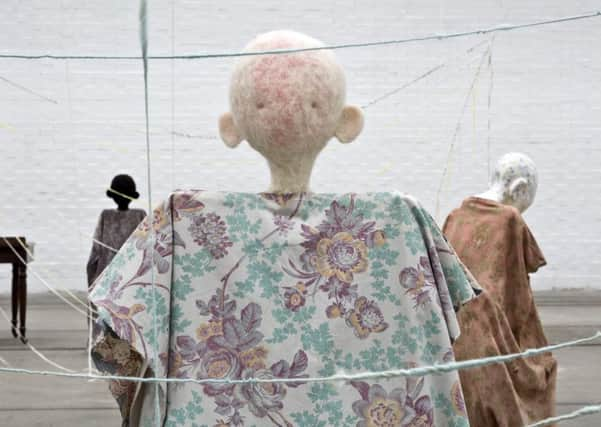Arts review: Cathy Wilkes


Cathy Wilkes
****
Tate Liverpool
On an incredibly windy day on Merseyside this week I was swept off my feet in more ways than one. The windows were rattling in the Albert Dock and outside the grey Mersey was choppy. Inside Tate Liverpool, at Glasgow artist Cathy Wilkes’s most comprehensive UK exhibition to date, it was impossible not to be similarly buffeted by an exhibition of considerable emotional force.
Wilkes’s show reconfigures elements of six of her sculptural installations from the last decade, to create a single linked tableau. The work has come on loan from private and public collections in Brussels, New York, Warsaw and Glasgow, among other cities. But the show is not a simple or faithful recreation of its constituent parts, it is a series of scenes that unfold gradually, each consisting of stooped human figures created from metal armatures dressed in faded antique textiles, with indeterminate faces and heads made from papier-mâché or felt and wool. Each figure is surrounded by found or constructed objects: a child emerges from behind an ink-stained cloth slung over a washing line, a stooped woman gathers soiled towelling, a man is hunched, desperate, over a beer bottle. Undoing conventional display methods, 12 of Wilkes’s small paintings are mounted on two metal grids rather than on the gallery walls. This method echoes both the complex metal roof structure of this uppermost gallery in the converted dockland warehouse and the sliding storage racks you will find in museum stores and the sculptural elements of her work. Smaller, more discrete objects have been mounted on similar raised platforms on the floor.
Advertisement
Hide AdWilkes, who was born in 1966 in Northern Ireland but who has lived in Glasgow since her studies at Glasgow School of Art, is in some ways a talismanic figure in contemporary art. Her work, which at times has met with stubborn resistance or hostility from some (male) critics, has proven to outlast and outmanoeuvre them.
She represented Scotland at the Venice Biennale in 2005 and was nominated for the Turner Prize in 2008. Her refusal to engage in some of the more accepted conventions of the cultural world, such as press interviews and social occasions, and her insistence that her work should stand on its physical merits alone without extensive written interpretation shouldn’t simply be seen as reticence.
She is in many ways a militant artist, seeking to insist on questions of women’s rights and domestic labour, the importance and autonomous role of children. In the past her work has explored themes of caring for the sick, of pregnancy and childbirth and the loss of her father. In Liverpool, the port setting gives her ragged people the feel of migrants or refugees. While Nigel Farage is railing against immigration, Wilkes’s figures suggest our own closeness to impoverishment and migration. Few of us are more than two or three generations away from hard scrabble, some of us closer still.
In the shiny newness of the art world her insistence on the worn and neglected is notable. At the last Venice Biennale in 2013 it was a palpable shock to encounter her work Untitled (Possil, at last), a heartrending tableau of a stooped male figure absorbed in drink surrounded by anxious figures of children. This work, now in the Tate collection, includes bottles and tankards from the Possil pottery in Glasgow, fragments of ceramics and cardboard boxes, each arranged with striking tenderness and care.
While we think of art in terms of active verbs, like shaping or making, Wilkes suggests that art and life might be a question of both doing and undoing. There is no such thing as careless or casual in her work. The placement of the tiniest stone marble on textile or the unfinished embroidery on a linen sampler are deliberate. But for every constructed object there is another that has reached its current state by some kind of attrition. Antique fabrics are sun-bleached, faded and distressed to the point of near dissolution. A plucked piece of heather is woody and dry. The found vessels that are such a feature of Wilkes’s work in the last decade, from domestic buckets to empty jam jars, are lined with a kind of scrim, the detritus of food or clay or pigment they once held.
On a formal level against all the metal grids, Wilkes sculpture suggests other directions. Her textiles are almost all floral. The round objects she uses suggest moons and cycles, the loops of life-cycles and infinities. Alone (2004) is a glass pane and a grinding machine, it is silent but you can imagine it endlessly spinning and almost a human character in itself. It too will age and become ground down as much as it will grind or burnish other objects.
Advertisement
Hide AdIn some of the stained buckets, or galvanised metal trays that populate the work, there is a sense that absence is as important as presence, what has evaporated or has been poured away is a potent metaphor for loss and absence. Her paintings have such an odd, uncertain quality because of similar processes: paint is applied and then scraped back.
This, it strikes me, is not just an aesthetic choice but also a political one. There is, for example, an evocation of the human touch. And Wilkes’s traces, stains and fragments are an insistence that we are shaped by the past as much as the present.
Advertisement
Hide AdRecently she seems to have been referring, if not quite to ghosts, then at least to the figures that we might carry with us from our past. It is a question of inheritance, not in the grand, male dynastic sense, but in the idea of kinship or community. Sometimes this seems a community between the living and the dead. In this, Wilkes’s art has a unique, expressive quality. Hers is a singular voice: persistent and important.
• Until 31 May
FOLLOW US
SCOTSMAN TABLET AND MOBILE APPS